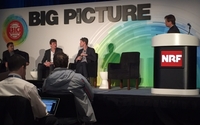 The road map of the mobile customer journey if not a bit bumpy is at
the very least becoming somewhat more complex.
The road map of the mobile customer journey if not a bit bumpy is at
the very least becoming somewhat more complex.
Some of the issues were candidly highlighted on the exhibit floor and in conference presentations at the annual show to which retailers trek in
hopes of finding the latest technologies and innovations to help them better address the customer path to purchase.
The NRF (National Retail Federation) convention and expo in New York is
called “Retail’s Big Show.” Though nowhere near CES big, the entire show is conveniently housed in the single location of the Javits Center, making it possible to see hundreds
of companies relatively easily.
Some of the complexities and marketplace evolutions were highlighted in an opening day panel about mastering the technological mobile roadmap on the new
customer journey.
advertisement
advertisement
The idea of disruption came up several times with numerous examples of how mobile is transforming shopping behavior.
Ryan Craver, former SVP of Hudson’s Bay and
Lord & Taylor, noted that there has been disruption in how people research, such as by using mobile phones and tablets before heading to a store.
For Staples, the issue of product pricing
is front and center.
“For us, transparency of pricing has become critical,” said Faisal Masud, EVP of global ecommerce at Staples. “If you don’t have the right price,
you’re in trouble.”
He also suggested that for retail in general, there is almost too much saturation of stores in the country, with the future of mobile purchasing evolving.
“A lot of these loyalty programs are a little bit doomed,” said Masud. “Google could be the shopping destination.”
For staying up to date with technological
advancements, Craver suggested looking into areas outside of retail. “There should be a relentless pursuit of what is happening in other industries,” he said.
For example, to look
at innovations in throughput, companies should study the approaches of quick service restaurants, many of whom have figured how to get customers in and out more efficiently.
Panelists
recounted issues over the holidays where some customers ordered digitally for in-store pickup only to face long lines once they arrived, totally negating the benefit of a quick mobile order.
“Change is very difficult,” Masud said, reporting that 13% of Staples transactions are order and pickup in store. As a result, Staples has increased its shipping to stores.
“Customers want to be able to make the decisions.”
Of those orders, Masud said half are by mobile and the other half by desktop. And of those, most mobile customers are consumers
and most desktop customers are businesses, he said.
“The word channel puts constraints on the way we think,” Masud said, mentioning yet another behavioral change with customers
texting with the company for more interactive experiences.
“This whole typing thing is going to become somewhat irrelevant,” Masud said, referring to the traditional online method
of ordering.
One of the issues addressed by the speakers was the role of mobile in acquiring new customers.
“For customer acquisition, if you want millennials, you have to use
mobile,” said Craver.
Over Christmas at Staples, mobile traffic accounted for 40% or more of all traffic, according to Masud. “I could easily see more than half in the
future.”
Retailers are not inherently technology companies. “We’ll see more retailers build out their own innovation,” Masud said.
We saw numerous mobile
shopping innovations at the NRF convention, especially in the coming uses of beacons.
More to come on all of that here. Stay tuned.
______________________________________
Check
out the coming MediaPost IoT: Beacons conference agenda for Chicago Feb. 10.